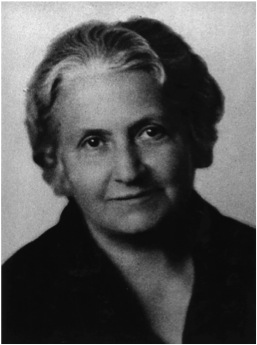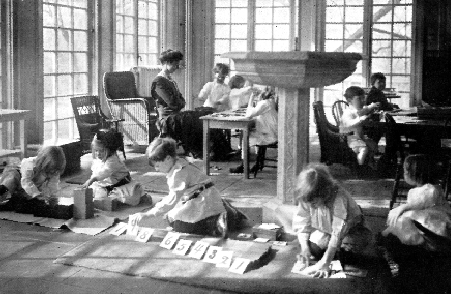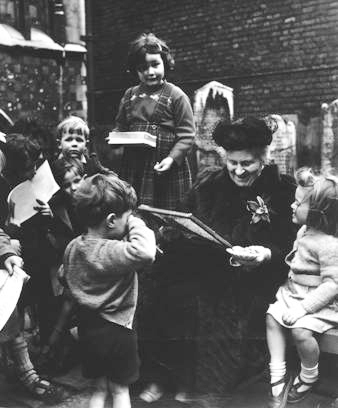- Treasure Village Montessori
- New Charter and Montessori
-
Charter Schools & The Montessori Method
“We must not dwell on his limitations, we must focus on his possibilities.” ~ Maria Montessori
The public is often surprised to learn that Treasure Village Montessori (TVM) has no tuition. It is free. Not all Montessori schools are. TVM is a both charter school and a Montessori school.
Charter Schools
In Florida, charter schools are public schools that are free of tuition. Charter Schools serve specific purposes depending on the needs of the community. Some charter schools serve at-risk populations, some gifted, and some are vocational, technical, cultural and philosophical like Treasure Village Montessori.

Maria MontessoriTreasure Village Montessori offers an alternative method to teaching for Monroe County students. In a district as unique as the Florida Keys, education choices are limited. In an effort to service Florida Keys children, the Monroe County School Board sponsors our charter, along with a few others throughout the Keys in an effort to meet the needs and wants of the members of the community regarding the education of its children.
In exchange for the ability to offer this type of choice in Monroe County, TVM has been given the freedom to hire our own staff, provided they meet state credential and security requirements and to develop and implement infinitely unique curriculums and programs. TVM may spend funding according to the needs and goals of our Montessori school's stake holders and has other abilities not readily available at traditional district schools. This freedom offers opportunities for our students far beyond those of many traditional public school district programs.
Accountability is vital. All this freedom is contingent upon the yearly success of our Montessori student achievement and the schools fiscal stability. Unlike traditional schools, charter schools that do not meet the requirements for student achievement and fiscal stability set by the state and district guidelines are subject to closure—unlike traditional schools that are given long-term strategies and plans to recover with time. As a result, Treasure Village Montessori is held highly accountable for how well we educate children in a safe and responsible environment. Each and every year if students do not perform to set standards our charter school risks closure. Higher standards, for us, mean higher expectations and thus higher achievements. This is challenge and challenge is good.
The Montessori Method, Maria Montessori — A visionary, an educator
Explaining the principles behind the Montessori schools, Maria Montessori wrote: There is a part of a child's soul that has always been unknown but which must be known. With a spirit of sacrifice and enthusiasm we must go in search, like those who travel to foreign lands and tear up mountains in their search for hidden gold.

Maria MontessoriMaria Montessori was born in Chiaravalle, Ancona, Italy in 1870. Her father, Alessandro, was a civil servant, her mother, Renilde Stoppani, a driving force in Marias education, was well-educated and loved reading. She was a descendant of scholars and soldiers.
She was a driven women who surpassed great odds to become one of the first women doctors in Italy, a feat not easily achieved today, but almost impossible in that day and age when the only available acceptable profession for women was teaching. These accomplishments in medicine and additional interests in anthropology, philosophy, psychiatry and experimental psychology laid the foundation for a rich background for her eventual life work in the education of children.
How It All Began
"I was searching for the reasons which could keep back the healthy and happy children of the ordinary schools on so low a plane that they could be equaled in tests of intelligence by the children with severe mental and physical disabilities", wrote Dr. Montessori.
The situation consumed her. In 1906 despite common worldviews that poor children were incapable of learning, she was given an opportunity to establish the first classroom for a group of 60 children, age 3 to 6, in a slum tenement in San Lorenzo, Rome, Italy. This group of children demonstrated spontaneous discipline, explosions of spontaneous writing and reading and free social life which astounded the populations around the world. In fact, the transformation was so great that there were many who were ready to believe that because she was a medical doctor, the real miracle must have been drugs!

Maria MontessoriMaria Montessori was regarded as an educational pioneer. Her belief in children and child-centered education radiated across the globe. There was a time in the early part of the 20th Century when it appeared her approach would be adopted widely—as the standard method—throughout education, due to its success.
More than 100 years since the establishment of that first classroom, the Montessori method and philosophy of teaching is being embraced and implemented around the world with exceptional results in student achievement.
What is the Montessori Method?
The Montessori method has revolutionized education. This method advocated that children be allowed the freedom to explore and develop their own academic and creative potential through a wealth of self-teaching educational materials. Dr. Montessori developed much of the educational equipment found today in the Montessori classroom nearly 100 years ago. This equipment includes hands-on math materials, phonetic reading systems, science materials in the areas of botany, zoology, history and geography, as well as additional areas including practical life and sensorial, which illustrate the many necessary life skills required for independent daily living. The child's avid interest in the real world is nurtured by these materials illustrating principles required by the state, as well as those that are of additional natural interests - all areas are explored with concrete objects, tactile experiments, projects, research and field trips. The students readily take up this reality based purposeful creative work designed to develop mental and manual dexterity and to prepare students with the tools for a lifetime of learning.

HIGHER STANDARDS, HIGHER EXPECTATIONS - TREASURE VILLAGE MONTESSORI
TVM Home | TVM Our Story | Charter & Montessori What They Are | Considering TVM? | Academics At TVM | TVM Program Highlights | TVM M.A.P.S | Info For TVM Students | TVM Parents Responsibilities | TVM Faculty & Administration | TVM Classes & Achievements | TVM Board & Committees | TVM Calendar & Events | TVM Enrollment Process | TVM Forms | Contact TVM / Directions
Accredited by: Southern Association of Colleges and Schools
Website Content & Maintenance: Jennifer Marble Consulting

